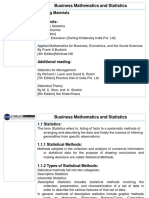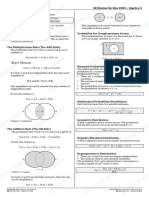840 Assignment
840 Assignment
Uploaded by
adewumimafCopyright:
Available Formats
840 Assignment
840 Assignment
Uploaded by
adewumimafOriginal Description:
Original Title
Copyright
Available Formats
Share this document
Did you find this document useful?
Is this content inappropriate?
Copyright:
Available Formats
840 Assignment
840 Assignment
Uploaded by
adewumimafCopyright:
Available Formats
MATRICULATION NUMBER; 239031013
MATRICULATION NUMBER; 239031013
NAME; ADEWUMI M. OLURIN
DEPT. ; ADULT EDUCATION [ COMMUNITY DEVELOPMENT AND SOCIAL WORK]
COURSE; FED 840 [ QUANTITATIVE RESEARCH METHODS]
QUESTION; DISCUSS ON THE FIRST TOPIC OF THE COURSE OUTLINE [ CONCEPTUAL
OVERVIEW].
DEADLINE; 8TH OF JAN., 2024.
A. STATISTICS
Statistics is the science concerned with developing and studying methods for collecting,
analyzing, interpreting and presenting empirical data
Statistics can also be defined in multiple ways, depending on the context and
perspective. Here are three definitions, each accompanied by an educational reference:
1. Statistics as a Branch of Mathematics:
• Definition: Statistics is a branch of mathematics dealing with the collection,
analysis, interpretation, and presentation of masses of numerical data..
2. Statistics as a Methodology:
• Definition: Statistics is the methodology of analyzing data, drawing conclusions,
and making decisions based on data analysis. It involves techniques for designing
experiments, surveys, and observational studies, as well as methods for data collection,
analysis, interpretation, and presentation.
3. Statistics as Applied in Various Fields:
• Definition: In various fields such as economics, biology, public health, sports, and
more, statistics is the science of using data to make decisions and predictions. It involves
applying statistical methods to solve real-world problems and to inform policy and
decision-making..
A[1] Applications of Statistics
Various application of statistics in mathematics are added below,
Statistics is used in mathematical computing.
Statistics is used in finding probability and chances.
Statistics is used in weather forcasting, etc.
MATRICULATION NUMBER; 239031013
A [2] Statistics Terminologies
Some of the most common terms you might come across in statistics are:
Population: It is actually a collection of a set of individual objects or events whose
properties are to be analyzed.
Sample: It is the subset of a population.
Variable: It is a characteristic that can have different values.
Parameter: It is numerical characteristic of population.
.
A[3] Types of Statistics
There are 2 types of statistics:
1. Descriptive Statistics
2. Inferential Statistics
Descriptive Statistics
Descriptive statistics uses data that provides a description of the population either
through numerical calculated graphs or tables. It provides a graphical summary of
data.
It is simply used for summarizing objects, etc. There are two categories in this as
follows.
Measure of Central tendency
Measure of Variability
Measure of Central Tendency
Measure of central tendency is also known as summary statistics that are used to
represent the center point or a particular value of a data set or sample set. In statistics,
there are three common measures of central tendency that are,
Mean
Median
Mode
Measure of Variability
The measure of Variability is also known as the measure of dispersion and is used to
describe variability in a sample or population. In statistics, there are three common
measures of variability as shown below:
1. Range of Data
It is a given measure of how to spread apart values in a sample set or data set.
Range = Maximum value – Minimum value
2. Variance
Variance describes how much a random variable defers from the expected value and it
is also computed as a square of deviation.
Inferential Statistics
Inferential Statistics makes inferences and predictions about the population based on
a sample of data taken from the population. It generalizes a large dataset and applies
probabilities to draw a conclusion.
Inferential statistics are generally used to determine how strong a relationship is
within the sample. However, it is very difficult to obtain a population list and draw a
random sample.
MATRICULATION NUMBER; 239031013
A [4] Applications of Statistics
Various application of statistics in mathematics are added below,
Statistics is used in mathematical computing.
Statistics is used in finding probability and chances.
Statistics is used in weather forcasting, etc.
B] Data in Statistics
Data is the collection of numbers, words or anything that can be arranged to form a
meaningful information. There are various types of the data in the statistics that are
added below,
B [1] Types of Data
Various types of Data used in statistics are,
Qualitative Data – Qualitative data is the descriptive data of any object. For
example, Kabir is tall, Kaira is thin, etc.
Quantitative Data – Quantitative data is the numerical data of any object. For
example, he ate three chapatis, and we are five friends.
Types of Quantitative Data
We have two types of quantitative data that include,
1. Discrete Data: The data that have fixed value is called discreate data, discreate
data can easily be counted.
2. Continuous Data: The data that has no fixed value and has a range of data is called
continuous data. It can be measured.
B [2] Representation of Data
We can easily represent the data using various graphs, charts or tables. Various types
of representing data set is,
Bar Graph
Pie Chart
Line Graph
Pictograph
Histogram
Frequency Distribution
C. MEASUREMENT
Measurement is the process of assigning numbers to events based on an established set of
rules. In educational measurement, the “events” under consideration are students' test
performances and, in the simplest case, the numerals assigned might be the students'
numbers of correct responses.
C [1] There are four types of measurement (or scales) to be aware
of: nominal, ordinal, interval, and ratio.
MATRICULATION NUMBER; 239031013
Nominal
The nominal scale simply categorizes variables according to qualitative labels (or
names). These labels and groupings don’t have any order or hierarchy to them, nor do
they convey any numerical value.
Ordinal
The ordinal scale also categorizes variables into labeled groups, and these categories
have an order or hierarchy to them.
Interval
The interval scale is a numerical scale which labels and orders variables, with a known,
evenly spaced interval between each of the values.
Ratio
The ratio scale is exactly the same as the interval scale, with one key difference: The
ratio scale has what’s known as a “true zero.”
REFERENCES
Ali, A. (1996). Fundamentals of Research in Education. Awka, Nigeria: Meks Publishers.
Anaekwe, M.C. (2002). Basic Research Methods and Statistics in Education and Social
Sciences. Enugu: Podiks Printing and Publishing Company.
Best, J.W. & Kahn, J.V. (1995). Research in Education (7th Edition). New Delhi: Prentice
Hall of India, 20 – 23.
Denga, I.D. & Ali, A. (1983). An Introduction to Research Methods and Statistics in
Education and Social Sciences. Jos: Savannah.
Ikekhua, T.I. & Yesufu, J.T. (1995). Exposing Research Methods inEducation Study and
Reporting aid for Students and BeginningResearchers. Warri: Ar B10 Publishing Limited.
You might also like
- WHLP Quarter 3 Week 1Document5 pagesWHLP Quarter 3 Week 1MaricarDimas100% (3)
- Statics 1 - Copy-1-2Document193 pagesStatics 1 - Copy-1-2Mohammed Ali100% (3)
- Stat Ch1and 2Document23 pagesStat Ch1and 2lindaasuraphelNo ratings yet
- Stat 1&2Document24 pagesStat 1&2የገጠር ልጅNo ratings yet
- CH 1Document20 pagesCH 1kidanemariam teseraNo ratings yet
- Chapter One: 1.1definition and Classification of StatisticsDocument22 pagesChapter One: 1.1definition and Classification of StatisticsasratNo ratings yet
- 2013 CH 1 Up 9 Probability NoteDocument104 pages2013 CH 1 Up 9 Probability NoteZemenu mandefroNo ratings yet
- CH 1 Up 9 Probability Note-1 PDFDocument106 pagesCH 1 Up 9 Probability Note-1 PDFMuket AgmasNo ratings yet
- Business Mathematics and StatisticsDocument9 pagesBusiness Mathematics and StatisticsAKB 1No ratings yet
- Probability and StatisticsDocument6 pagesProbability and Statisticssubhan sibghatNo ratings yet
- Stat 1-3 ChaptersDocument36 pagesStat 1-3 ChaptersGizachew NadewNo ratings yet
- StatisticsDocument11 pagesStatisticsCruspero LennyNo ratings yet
- Statiscal Method Using RDocument150 pagesStatiscal Method Using R20BCS2512 Yashendra RajputNo ratings yet
- Chapter One: The Subject Matter of Statistics 1.1. Definition of StatisticsDocument11 pagesChapter One: The Subject Matter of Statistics 1.1. Definition of StatisticsSitra Abdu100% (1)
- CH 1 Up 9 Probability Note (For Engineering) - 1Document93 pagesCH 1 Up 9 Probability Note (For Engineering) - 1tazeb AbebeNo ratings yet
- Chapter 1Document16 pagesChapter 1hussein mohammedNo ratings yet
- Statistics and Probablity Note For EngineersDocument79 pagesStatistics and Probablity Note For EngineerstasheebedaneNo ratings yet
- 1 FfaaDocument9 pages1 FfaaUsman FeyisaNo ratings yet
- CH 1 Up 9 Probability Note-1Document91 pagesCH 1 Up 9 Probability Note-1Onetwothree Tube100% (1)
- Stat CH 1 Lec Note - 231109 - 164005Document4 pagesStat CH 1 Lec Note - 231109 - 164005Man SanchoNo ratings yet
- Scholarly Publication-CHAPTER 1 & 2.pdf261-1176727076Document25 pagesScholarly Publication-CHAPTER 1 & 2.pdf261-1176727076lataNo ratings yet
- Chapter No 1 StatisticsDocument7 pagesChapter No 1 StatisticsAmeer HaiderNo ratings yet
- Stat I CH - IDocument19 pagesStat I CH - Ibrucknasu279No ratings yet
- Business Statistics3Document18 pagesBusiness Statistics3Odi OdoNo ratings yet
- Element of Stat - Docx 11111Document12 pagesElement of Stat - Docx 11111kvjlano2No ratings yet
- Business Mathematics and Statistics: Reading Materials Core TextsDocument9 pagesBusiness Mathematics and Statistics: Reading Materials Core TextsGavaskar EzhilarasanNo ratings yet
- Mathematics As A ToolDocument21 pagesMathematics As A ToolSibuyan MannyNo ratings yet
- STATISTICSDocument98 pagesSTATISTICSJimboy SapalNo ratings yet
- Basic StatisticsDocument53 pagesBasic Statisticsአንተነህ የእናቱNo ratings yet
- Stat Int Note1Document70 pagesStat Int Note1Tigist TilahunNo ratings yet
- Basic Stat 1-2 PDF-1-1Document15 pagesBasic Stat 1-2 PDF-1-1efrem atsbahaNo ratings yet
- GizawDocument78 pagesGizawGizaw FulasNo ratings yet
- Chapter 1 - Definition and Uses of Statistics - 1Document15 pagesChapter 1 - Definition and Uses of Statistics - 11974 Kazi SatiNo ratings yet
- Chapter - 1: Introduction To Probability and Statistics For Civil EngineeringDocument18 pagesChapter - 1: Introduction To Probability and Statistics For Civil Engineeringznour alyNo ratings yet
- Statistics For Management IDocument82 pagesStatistics For Management Iyohannestesfaye064No ratings yet
- SatatisticsDocument40 pagesSatatisticssamuelmeresa19No ratings yet
- Bussiness StatDocument32 pagesBussiness StatGizaw FulasNo ratings yet
- Introduction in Satistics HebaDocument16 pagesIntroduction in Satistics HebaMohamed FathyNo ratings yet
- Introduction To StatisticsDocument53 pagesIntroduction To Statisticsmubasher akramNo ratings yet
- Chapter OneDocument7 pagesChapter Onehariye2225No ratings yet
- Statatics Cha 1Document8 pagesStatatics Cha 1Haftom GebreegziabiherNo ratings yet
- Awoke Introduction To StatisticsDocument147 pagesAwoke Introduction To Statisticsdabala100% (2)
- Statstics Full HandoutDocument95 pagesStatstics Full HandoutTemesgen Zeleke0% (1)
- CHAPTER ONE Stat IDocument6 pagesCHAPTER ONE Stat IroberaakNo ratings yet
- StatisticsDocument88 pagesStatisticsbot.iot555No ratings yet
- Stat I Chapter 1 and 2Document29 pagesStat I Chapter 1 and 2biyadgendeshewNo ratings yet
- Chapter 1 IntroductionsDocument5 pagesChapter 1 IntroductionskoangyakNo ratings yet
- Introductio To Statistics Module in DMUDocument100 pagesIntroductio To Statistics Module in DMUalemumelsNo ratings yet
- Lecture Note Basic StatisticsDocument73 pagesLecture Note Basic Statisticsmenberutadese2015No ratings yet
- CH 1 StatsDocument4 pagesCH 1 StatsSriram SwaminathanNo ratings yet
- M.sc. StatisticsDocument18 pagesM.sc. StatisticsNageshwar YadavNo ratings yet
- Chap 1 Introduction To StatisticsDocument6 pagesChap 1 Introduction To StatisticslindaasuraphelNo ratings yet
- Chapter 1 IntroductionDocument6 pagesChapter 1 Introductionasuasan151No ratings yet
- Business AnalyticsDocument40 pagesBusiness Analyticsvaishnavidevi dharmarajNo ratings yet
- Business Statistics I BBA 1303: Muktasha Deena Chowdhury Assistant Professor, Statistics, AUBDocument54 pagesBusiness Statistics I BBA 1303: Muktasha Deena Chowdhury Assistant Professor, Statistics, AUBKhairul Hasan100% (1)
- Fba 324 Research SeminarDocument7 pagesFba 324 Research SeminarEMMANUEL LEKANNo ratings yet
- Basic StatDocument31 pagesBasic StatBeke derejeNo ratings yet
- Chapter 1 IntroductionDocument9 pagesChapter 1 IntroductionDinksrawNo ratings yet
- Descriptive Staticstics: College of Information and Computing SciencesDocument28 pagesDescriptive Staticstics: College of Information and Computing SciencesArt IjbNo ratings yet
- Presentation On Data Analysis: Submitted byDocument38 pagesPresentation On Data Analysis: Submitted byAmisha PopliNo ratings yet
- Unit IV Uncertain Knowledge and Decision TheoryDocument54 pagesUnit IV Uncertain Knowledge and Decision TheoryPallavi BhartiNo ratings yet
- Exponential DistributionDocument15 pagesExponential DistributionThejaswiniNo ratings yet
- Negative Exponential DistributionDocument3 pagesNegative Exponential DistributionEmily ScottNo ratings yet
- Activities 1-5 - BoncalesDocument12 pagesActivities 1-5 - BoncalesBraille Boncales100% (1)
- The Idiomatic Programmer - Statistics PrimerDocument44 pagesThe Idiomatic Programmer - Statistics PrimerssignnNo ratings yet
- FRM一级百题 数量分析Document67 pagesFRM一级百题 数量分析bertie RNo ratings yet
- CH06 Notes LectureDocument35 pagesCH06 Notes LectureHerard NapuecasNo ratings yet
- Lecture Notes 1: Brief Review of Basic Probability (Casella and Berger Chapters 1-4)Document14 pagesLecture Notes 1: Brief Review of Basic Probability (Casella and Berger Chapters 1-4)ravikumar rayalaNo ratings yet
- Sem3 Stat PYQsDocument6 pagesSem3 Stat PYQsdayamariapbNo ratings yet
- Assessment of Generation Adequacy by Modeling A Joint Probability Distribution ModelDocument9 pagesAssessment of Generation Adequacy by Modeling A Joint Probability Distribution ModelJuan David HernándezNo ratings yet
- Module 4 - Fundamentals of ProbabilityDocument50 pagesModule 4 - Fundamentals of ProbabilitybindewaNo ratings yet
- H13 321 Full File Odghv0 - 2Document46 pagesH13 321 Full File Odghv0 - 2ahmed01067393475No ratings yet
- Maths F113 HandoutDocument3 pagesMaths F113 HandoutHari KrushnaNo ratings yet
- Accident ModellingDocument35 pagesAccident ModellingFireProtectionEngineerNo ratings yet
- PTSP r20-DEC-2023Document8 pagesPTSP r20-DEC-2023PRABHU DEVANo ratings yet
- PythonDocument114 pagesPythonGilberto MoreiraNo ratings yet
- PR 2 2nd Quarter ReviewerDocument21 pagesPR 2 2nd Quarter ReviewerNathaniel Dollete Panerio100% (1)
- Mean and Random VariableDocument4 pagesMean and Random VariabledfgftjhfjsNo ratings yet
- Wiley - Interscience.elements - Of.information - Theory.jul.2006.ebook DDUDocument774 pagesWiley - Interscience.elements - Of.information - Theory.jul.2006.ebook DDUmiguel vivert100% (3)
- ECON 2P91: Assignment #1Document7 pagesECON 2P91: Assignment #1Joel Christian MascariñaNo ratings yet
- MSC Artificial Intll Ud 2024 25 (1) - OKDocument75 pagesMSC Artificial Intll Ud 2024 25 (1) - OKnirmala.deviNo ratings yet
- CH 2Document24 pagesCH 2dqvietd2vNo ratings yet
- Engineering, Vol. 112, No. 4, November, 1986. ©ASCE, ISSN 0733-9437/86/0004Document17 pagesEngineering, Vol. 112, No. 4, November, 1986. ©ASCE, ISSN 0733-9437/86/0004enes7No ratings yet
- R Course FileDocument18 pagesR Course Filemukkapati narendraNo ratings yet
- Statistics in Economics and ManagementDocument592 pagesStatistics in Economics and ManagementChefuur100% (2)
- Geometric Distribution: Created by T. MadasDocument18 pagesGeometric Distribution: Created by T. Madasabdul ahadNo ratings yet
- Revised Brochure BStat (2016)Document45 pagesRevised Brochure BStat (2016)Dr. Mousumi BoralNo ratings yet
- BME OM Finals 4Document9 pagesBME OM Finals 4Lorraine Noquilla TabaldoNo ratings yet
- Algebra Set 6Document3 pagesAlgebra Set 6mammasddNo ratings yet

























































































